#cometary
Text

Cometary Knots around a Dying Star
79 notes
·
View notes
Text
OUMUAMUA EL OBJETO EXTRASOLAR
La mentirosa NASA ha determinado de que el objeto extrasolar bautizado como OUMUAMUA no és más que un "fractal cometario" procedent de la fábrica de cometas que és la NUBE DE OORT, y que por esas leyes del universo ha sido "lanzado al espacio" surcando todo nuestro sistema solar.
De confirmarse esto; se echa por tierra las torias del astrofisico #AviLoeb, quien dudando del origen del objeto manifestó de que posiblemente se trataba de uuna sonda ó nave extraterrestre "a la deriva".
---------------------------------------------------------------
The lying NASA has determined that the extrasolar object named OUMUAMUA is nothing more than a "cometary fractal" coming from the comet factory that is the OORT CLOUD, and that by these laws of the universe it has been "launched into space" crossing our entire solar system. If this is confirmed; The theories of astrophysicist #AviLoeb are thrown to the ground, who, doubting the origin of the object, stated that it was possibly a "drifting" extraterrestrial probe or ship.

1 note
·
View note
Text

NGC 5367 // Juan Manuel
#astronomy#astrophotography#nebula#reflection nebula#dust#interstellar dust#cometary globule#NGC 5367#CG12#centaurus
59 notes
·
View notes
Text

At the Edge of the Helix - April 22nd, 1996.
"While exploring the inner edge of the Helix Nebula with the Hubble Space Telescope's Wide Field Planetary Camera 2, astronomers were able to produce this striking image - rich in details of an exotic environment. This planetary nebula, created near the final phase of a Sun-like star's life, is composed of tenuous shells of gas ejected by the hot central star. The atoms of gas, stripped of electrons by ultraviolet radiation from the central star, radiate light at characteristic energies, allowing specific chemical elements to be identified. In this image, emission from nitrogen is represented as red, hydrogen emission as green, and oxygen as blue. The inner edge of the nebula (the direction to the central star) is toward the top left. Clearly visible close to the inner edge are finger shaped "cometary knots"."
63 notes
·
View notes
Text



Got my collection of The Kingdom!
#the kingdom#riget#the kigdom exodus#and watch whatever has cometary woth it and rewatching in general#hyped to dig into the extras#also the postcards are going on my wall#lars von trier#talks
2 notes
·
View notes
Text
now we are talking about GOLF ?!?
0 notes
Text


Cosmic campfire!
HH 120's 'baby star jets' are glowing ember like in CG30, in its neighbourhood of this 'Cometary Globule Complex in Puppis'.
Astrophotography by Kevin Morefield.
In the detail image: HH 120, Herbig-Haro object 120, is in CG30. Its glow is from embedded protostars' stellar winds, or jets of gas, which form shockwaves when colliding with nearby gas and dust.
In the whole image: 2 of the other Cometary Globules are CG38, dim, at top, above CG30, & CG31, the tall 'mountain' in the middle.
0 notes
Photo

2024 August 8
Periodic Comet Swift-Tuttle
Image Credit & Copyright: Gerald Rhemann
Explanation: A Halley-type comet with an orbital period of about 133 years, Comet 109P/Swift-Tuttle is recognized as the parent of the annual Perseid Meteor Shower. The comet's last visit to the inner Solar System was in 1992. Then, it did not become easily visible to the naked eye, but it did become bright enough to see from most locations with binoculars and small telescopes. This stunning color image of Swift-Tuttle's greenish coma, long ion tail and dust tail was recorded using film on November 24, 1992. That was about 16 days after the large periodic comet's closest approach to Earth. Comet Swift-Tuttle is expected to next make an impressive appearance in night skies in 2126. Meanwhile, dusty cometary debris left along the orbit of Swift-Tuttle will continue to be swept up creating planet Earth's best-known July and August meteor shower.
∞ Source: apod.nasa.gov/apod/ap240808.html
156 notes
·
View notes
Photo
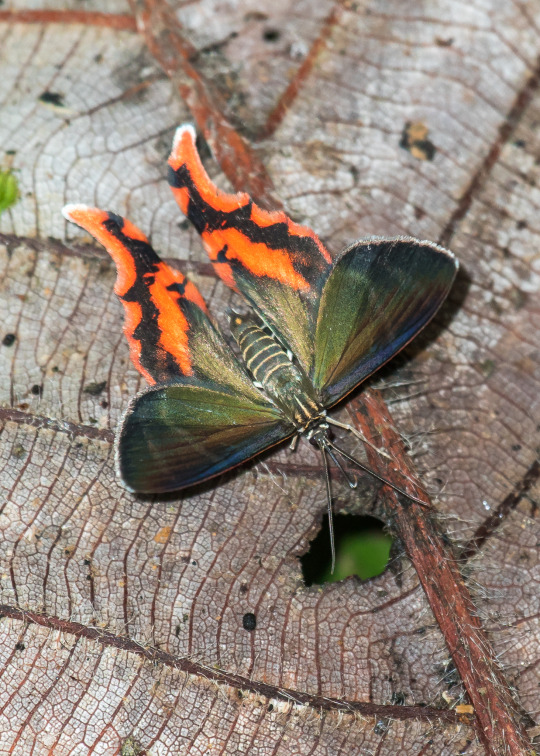
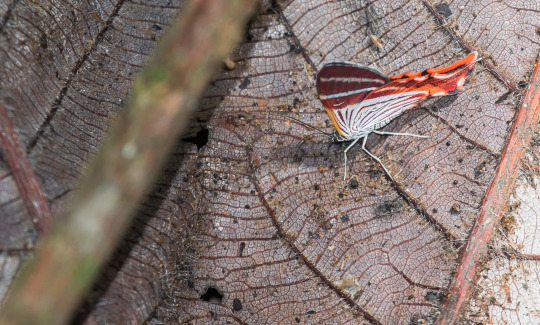
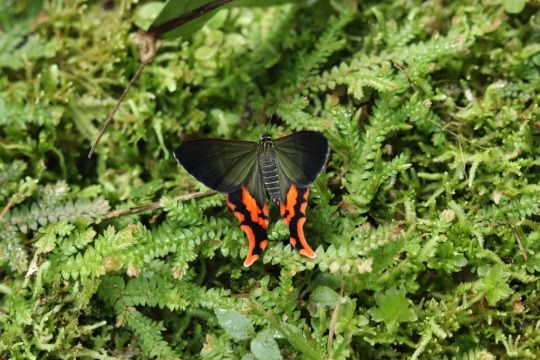

Comet geometer moth, Erateina cometaris, Geometridae
Found in Colombia and Ecuador
Photos 1-2 by monroyfotografo and 3-4 by andresarbol
3K notes
·
View notes
Text
Hoshikuzu Telepath - Episode 1: Cometary Encounter
Studio Gokumi, 2023
603 notes
·
View notes
Text
WITCH HEAD NEBULA * IC 2118 (also known as Witch Head Nebula due to its shape) is an extremely faint reflection nebula believed to be an ancient supernova remnant or gas cloud illuminated by nearby supergiant star Rigel in the constellation of Orion. It lies in the Orion constellation, about 900 light-years from Earth. The nature of the dust particles, reflecting blue light better than red, is a factor in giving the Witch Head its blue color. Radio observations show substantial carbon monoxide emission throughout parts of IC 2118, an indicator of the presence of molecular clouds and star formation in the nebula. In fact candidates for pre-main sequence stars and some classic T-Tauri stars have been found deep within the nebula. The molecular clouds of IC 2118 are probably juxtaposed to the outer boundaries of the vast Orion-Eridanus bubble, a giant supershell of molecular hydrogen blown by the high mass stars of the Orion OB1 association. As the supershell expands into the interstellar medium, favorable circumstances for star formation occur. IC 2118 is located in one such area. The wind blown appearance and cometary shape of the bright reflection nebula is highly suggestive of a strong association with the high mass luminous stars of Orion OB1. The fact that the heads of the cometary clouds of IC2118 point northeast towards the association is strong support of that relationship.. Credit to Pablo Carlos Budassi.

#nebula and quasar#dark nebula#nebulosa#neutron stars#planetary nebula#nebula#astronomy#astronomers#nasa#universe#nasa photos#astrophotography#astrophysics#outer space#nasawebb#hubble space telescope#space exploration#space#science#james webb space telescope#space shuttle#science facts#nasa science#planetary science#planet earth#i love astronomy#astronomy facts#cosmos#the universe#nasaastronaut
112 notes
·
View notes
Photo

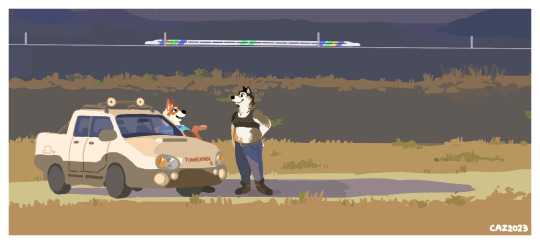
Yarragardee Basin, Mangala, 7995 A.D.
------------------------
Accompanying music: You’re On Fire by They Might Be Giants. Summer road trip music of all time, in my opinion.
Here’s a little expository write-up on the history and geography of the worlds shown here. Someday I’ll have more to show of the personal story of these two critters and their travels; until then, a more macro-level description.
------------------------
(most of this info has become outdated as modeling invalidated some original assumptions and I changed my mind on what I wanted here; future art of Mangala will reflect this)
Mangala and its sister world Kahira (visible in the background) are binary planets, orbiting one another in a manner not entirely unlike that of Pluto and Charon in the Solar System. Mangala is a relatively small world - just about twenty percent the mass of the Earth, something like if you took two copies of Mars and smushed them together; without the internal heat to drive a carbonate cycle long term, it had long been a frozen, dusty, and arid place when transhumanity first established a permanent presence in the Tahoka system almost a thousand years ago. Since those early days, terraforming using a Birchian soletta system (a huge but foil-thin Fresnel lens of mirrors, with a secondary focal lens for burning atmospheric gasses out of the regolith) has rendered it shirtsleeve habitable to baseline humans across much of the surface, although the global water inventory remains low* and the air in the “continental” uplands is stratospheric, with only the hardiest lichens establishing a foothold. Most of Mangala’s major metropolitan areas are located in the deep rift valleys and basins, where air pressure is highest.
Kahira on the other hand, a rock almost a fifth the mass of its sister world (a little under the mass of old Mercury), remains only slightly terraformed - surface conditions are persistently cold, with a thin barely-Martian atmosphere. Some of its larger rift valleys and craters have been tented over, aerated, and planted with tall low-gravity forest and grassland, a style of habitat construction dating back to the first Mars colonists almost six thousand years ago. Industrial complexes and buried cities sprawl out across the bare surface of the moon, with huge low-gravity lava tubes seeing extensive urban development.
The Yarragardee Basin, pictured above, is a graben basin in Mangala’s northern hemisphere, notable for the historic industrial city of Tirupati - here we see two road-trippers between cities on the basin’s great plain, taking a break in the long late afternoon of a sunset-day***. Having stopped for a night at a motel near Tirupati’s aerospace complex, they’re now continuing their journey to the city of Redmond-Tonasket, located in the Woronora Valles trench system about two thousand kilometers to the southwest.
* While plenty of water could have been imported from Tahoka’s cometary halo, it was decided not to do so in order to avoid inundating pre-existing cities in the valleys and deep basins. The extremely humid hothouse conditions that come after slamming dismantled ice moons through the stratosphere at over six kilometers a second were also broadly considered unacceptable.
** Smaller worlds have been terraformed in transhuman space, both by worldhouse and more open-air methods, but it’s largely the kind of thing that much more energy-rich systems do as a vanity project. Kahira may someday see blue skies, but likely not for a thousand years at least. (edit, one year later: I actually changed up some of this while simulating this system for stability. I’ll be posting more about this soon.)
*** Mangala and Kahira, being tidally locked to each other such that they always show one another the same face as they orbit their common center of mass, both have days exactly as long as their orbital periods - 403 kiloseconds, or roughly 112 hours. This is for convenience divided into month-weeks comprising four “circadian days” of 100 kiloseconds (~26 hours), with the remaining three kiloseconds added on to the last day of a month-week to keep synchronization.
594 notes
·
View notes
Photo

The reflection nebula NGC 5367 embedded in the cometary globule CG 12 // Jay Grevell
#astronomy#astrophotography#nebula#reflection nebula#dust#interstellar dust#dark nebula#cometary globule#NGC 5367#CG 12#centaurus
76 notes
·
View notes
Text

Cometary Knots in the Helix Nebula - April 16th, 1996.
"Four hundred fifty light-years from Earth, the wind from a dying, Sun-like star produced a planetary nebula, popularly known as the Helix. While exploring the Helix's gaseous envelope with the Hubble Space Telescope (HST), astronomers discovered indications of 1,000s of striking "cometary knots" like those shown above. So called because of their resemblence to comets, they are actually much larger - their heads are several billion miles across (roughly twice the size of the our Solar System itself) while their tails, pointing radially away from the central star, stretch over 100 billion miles. Previously known from ground-based observations, the sheer number of cometary knots found in this single nebula is astonishing. What caused them to form? Hot, fast moving shells of nebular gas overrunning cooler, denser, slower shells ejected by the star during an earlier expansion may produce these droplet-like condensations, as the two shells intermix and fragment. An intriguing possibility is that instead of dissipating over time, these objects could collapse and form Pluto-like bodies. If so, these icy worlds created near the end of a star's life would be numerous in our galaxy."
56 notes
·
View notes
Photo
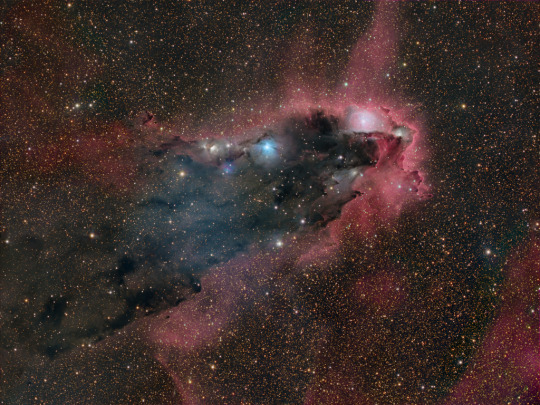
The Dark Tower in Scorpius, 2024-08-22
In silhouette against a crowded star field along the tail of the arachnological constellation Scorpius, this dusty cosmic cloud evokes for some the image of an ominous dark tower. In fact, monstrous clumps of dust and molecular gas collapsing to form stars may well lurk within the dark nebula, a structure that spans almost 40 light-years across this gorgeous telescopic portrait. A cometary globule, the swept-back cloud is shaped by intense ultraviolet radiation from the OB association of very hot stars in NGC 6231, off the upper right corner of the scene. That energetic ultraviolet light also powers the globule's bordering reddish glow of hydrogen gas. Hot stars embedded in the dust can be seen as bluish reflection nebulae. This dark tower and associated nebulae are about 5,000 light-years away. Growing Gallery: Moon Eclipses Saturn in August 2024
Credits: NASA's 'Astronomy Picture Of The Day.'
30 notes
·
View notes
Photo

Curious Cometary Knots in the Helix Nebula
Credits: C. R. O'Dell, Rice University, NASA
50 notes
·
View notes